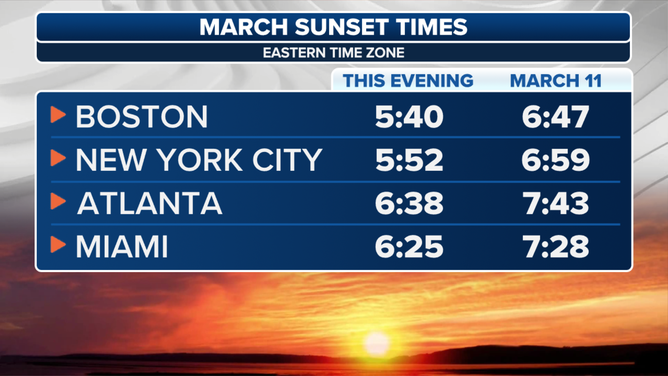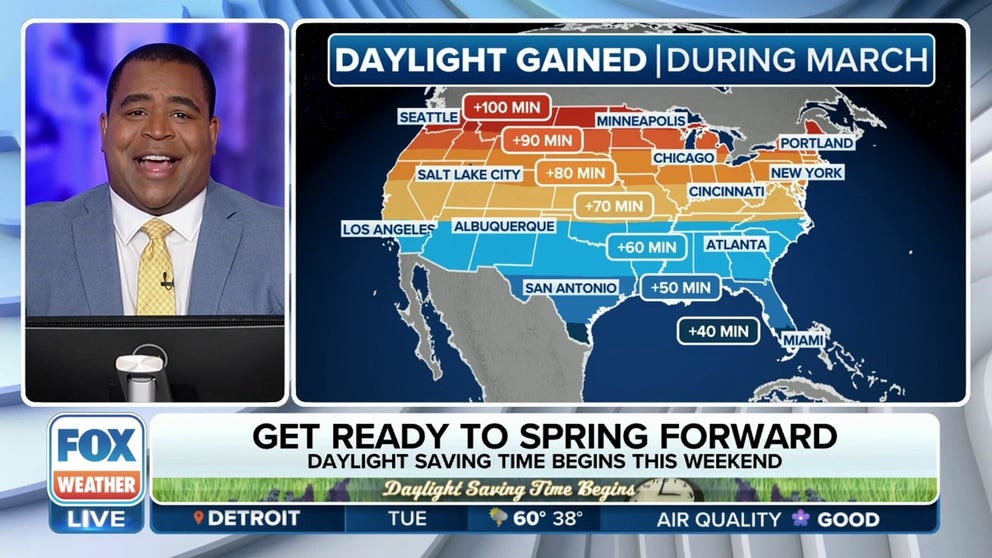Spring forward: Daylight saving time begins this weekend for most of the US
Daylight saving time begins on the second Sunday in March. This year you'll loose one hour of sleep on Sunday, March 10 when the clocks spring forward at 2 a.m.
Spring forward: Daylight saving time begins on Sunday
Most of the U.S. begins daylight saving time on Sunday losing one hour of sleep but gaining more sunlight later in the day throughout March.
This Sunday, March 10, marks the beginning of daylight saving time when most across the U.S. spring forward, moving their clocks up by one hour.
This is your notice that the time change is coming. Here's what you need to know about daylight saving time and how to prepare yourself and your family before it happens.
When is daylight saving time?
Clocks will officially go ahead an hour at 2 a.m. Sunday.
If you use your smartphone as an alarm, there is no need to do anything, but if an analog or digital clock not connected to Wi-Fi is your wake-up reminder, go ahead and set the clock one hour ahead before you go to bed.
Daylight saving time is observed from the second Sunday in March to the first Sunday in November, according to the U.S. Department of Transportation. The USDOT has overseen the time change since 1966, when Congress transferred responsibility from the Interstate Commerce Commission.

Daylight gained through March
(FOX Weather)
THE HISTORY OF DAYLIGHT SAVING TIME
Sunsets will be pushed later in the day with the time shift, combined with more minutes of overall daylight throughout March as Earth's Northern Hemisphere tilts closer to the sun on its way to the summer solstice.
The daylight gained this month is most substantial for states in the Northern Tier. The map above shows that cities north of Atlanta will earn more than an hour of additional sunlight by the end of March.

March sunset times for the eastern U.S.
(FOX Weather)
After DST begins, sunset will move back by more than an hour and progressively get later toward the end of March.
Daylight saving time ends this year on Nov. 3.
Which states observe daylight saving time?
Everywhere in the U.S., except Hawaii and most of Arizona, observes the time change. To make matters more confusing, the Navajo Nation in Arizona does observe DST. Some U.S. territories, including Puerto Rico and the Virgin Islands, do not change their clocks twice yearly.
DAYLIGHT SAVING TIME 2024: WILL SUNSHINE PROTECTION ACT MAKE DST PERMANENT?
There have been several attempts to make daylight saving time the year-round standard through the Sunshine Protection Act. However, the bill has yet to make it through the House and to the president's desk to become law.
How parents can help children transition to daylight saving time change
Sleep-deprived parents in states that observe DST are probably thinking, "Didn't we just go through this?"
The transition from DST to Standard time and vice versa can be rough for little ones and their parents. There are several sleep experts with recommendations to help your children adjust to the time change.

2022 FILE PHOTO: A 3-year-old boy naps on his first day at Our Loving Village, a licensed childcare run in the home of BriTanya Bays on February 21, 2022 in Stamford, Texas. (Photo by Bonnie Jo Mount/The Washington Post via Getty Images)
Pediatrician Dr. Harvey Karp, the author of "The Happiest Baby on the Block," recommends a gradual transition to the new bedtime.
"Every evening — for the four or so evenings leading up to daylight saving time — shift dinner and bedtime 15 minutes earlier if in spring, and 15 minutes later if in fall," Karp writes. "Four nights tends to work well for most children, but your child may only need two nights, depending on your baby or toddler’s temperament."
10 THINGS TO CHANGE IN YOUR HOME WHEN YOU CHANGE YOUR CLOCKS
Karp also recommends getting in some quality outdoor time in the morning during this transition. Karp said it helps toddlers and older children burn lots of energy and exposes them to sunlight, which produces the sleep hormone melatonin.
The baby sleep gurus of "Moms on Call" have more tips in a "No Fail Guide" to transitioning through daylight saving time.
The biggest suggestion by all sleep experts is to stick to your bedtime routine, whether that's a bottle, bath and a book or whatever order works for your little one.
